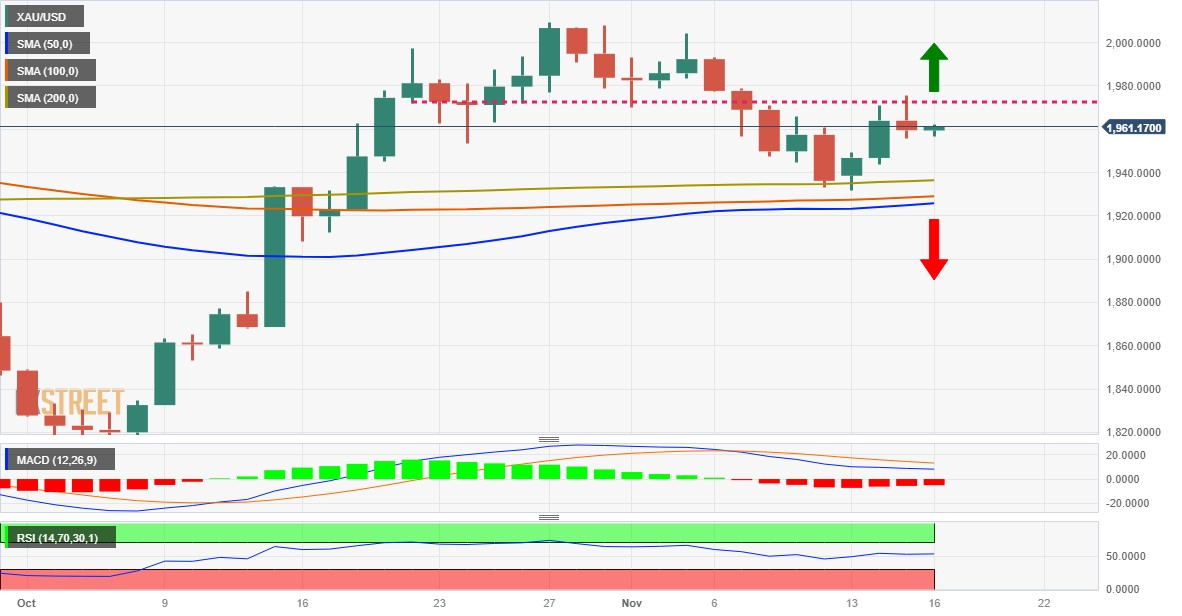- The price of Gold receives fresh buying on Thursday and is supported by a softer tone in the stock markets.
- The US dollar extends the previous day’s bounce from a two-month low and should limit XAU/USD’s gains.
- Expectations that the Federal Reserve will not raise interest rates further could act as a headwind for the Dollar.
The price of Gold (XAU/USD) has continued its intraday rise during the early stages of the European session on Thursday and has once again approached its one-week high, around the $1,975-$1,976 area reached on yesterday. The softer tone around US stock index futures is seen as a key factor driving some safe-haven flows into the precious metal. Apart from this, expectations that the Federal Reserve (Fed) has ended its monetary policy tightening campaign lend additional support to the yellow metal, which does not offer yields.
That said, a fresh recovery in the US Dollar (USD), from its lowest level since September 1 hit in the wake of Tuesday’s softer US CPI report, could keep any further gains for the price at bay. Gold. US retail sales fell less than expected in October, which, along with an upward revision to the previous month’s already stronger reading, suggests the economy is on track for a soft landing. This continues to support the Dollar and warrants caution before opening bullish positions on XAU/USD.
Daily Market Summary: Gold Price Continues to Rise Amid Fed Pause Hopes and Softer Risk Tone
- The US Producer Price Index (PPI) recorded its biggest drop since April 2020 and was down 0.5% in October. Additionally, September data was also revised downward to show a PPI increase of 0.4% instead of 0.5%.
- This comes on top of Tuesday’s US CPI report, which showed consumer inflation was cooling faster than expected, and reinforced expectations that the Federal Reserve is done raising interest rates.
- US retail sales fell in October for the first time in seven months, although the decline was smaller than expected and was accompanied by an upward revision to September data, which showed strong gains.
- San Francisco Fed President Mary Daly highlighted uncertainty over whether the central bank has done enough to bring consumer prices back to its 2% target in an interview with the Financial Times on Wednesday.
- This clouded the outlook for when the Fed will begin cutting interest rates, which is seen as offering some support to the US dollar and should help keep any significant bullish move for the price of Gold at bay.
- Mixed signals from high-level talks between the US and China tempered investor appetite for riskier assets and boosted demand for traditional safe-haven assets, allowing the precious metal to consolidate its intraday rise.
- Market participants are now looking forward to the US economic agenda, with the release of initial weekly jobless claims, the Philadelphia Fed manufacturing index and industrial production figures providing further impetus.
- Apart from this, the speeches of influential Fed officials will be analyzed for clues on the near-term policy outlook and will further contribute to producing short-term opportunities around the XAU/USD.
Technical Analysis: Gold price needs to strengthen beyond $1,975-$1,976 for bulls to regain control
From a technical point of view, the one-week high around the $1,975-$1,976 area touched on Wednesday now appears to act as an immediate hurdle. If the bullish trend continues, the price of Gold could reach $1,991-$1,992, on its way towards the psychological level of $2,000. The momentum could extend towards a multi-month high around the $2,009-$2,010 region, which if broken decisively will be seen as a new trigger for the bulls and pave the way for a fresh near-term appreciation move. .
On the opposite side, the $1,955-$1,950 zone is likely to protect the immediate decline ahead of the 200-day SMA, currently near the $1,935 region. Closely followed by the confluence of the 100-day and 50-day SMAs, around the $1,928-$1,925 zone, below which the price of Gold could become vulnerable and accelerate the decline towards the round $1,900 level. .
Frequently asked questions about Gold
Why invest in Gold?
Gold has played a fundamental role in human history, as it has been widely used as a store of value and medium of exchange. Today, aside from its brilliance and use for jewelry, the precious metal is considered a safe-haven asset, meaning it is considered a good investment in turbulent times. Gold is also considered a hedge against inflation and currency depreciation, since it does not depend on any specific issuer or government.
Who buys more Gold?
Central banks are the largest holders of Gold. In their aim to support their currencies in turbulent times, central banks tend to diversify their reserves and purchase Gold to improve the perception of strength of the economy and currency. High Gold reserves can be a source of confidence for the solvency of a country. Central banks added 1,136 tons of gold worth about $70 billion to their reserves in 2022, according to data from the World Gold Council. This is the largest annual purchase since records exist. Central banks in emerging economies such as China, India and Turkey are rapidly increasing their gold reserves.
What correlation does Gold have with other assets?
Gold has an inverse correlation with the US Dollar and US Treasuries, which are the main reserve and safe haven assets. When the Dollar depreciates, the price of Gold tends to rise, allowing investors and central banks to diversify their assets in turbulent times. Gold is also inversely correlated with risk assets. A rally in the stock market tends to weaken the price of Gold, while sell-offs in riskier markets tend to favor the precious metal.
What does the price of Gold depend on?
The price of Gold can move due to a wide range of factors. Geopolitical instability or fear of a deep recession can cause the price of Gold to rise rapidly due to its status as a safe haven asset. As a non-yielding asset, the price of Gold tends to rise when interest rates fall, while rising money prices tend to weigh down the yellow metal. Still, most of the moves depend on how the US Dollar (USD) performs, as the asset is traded in dollars (XAU/USD). A strong Dollar tends to keep the price of Gold in check, while a weaker Dollar is likely to push up Gold prices.
Source: Fx Street
I am Joshua Winder, a senior-level journalist and editor at World Stock Market. I specialize in covering news related to the stock market and economic trends. With more than 8 years of experience in this field, I have become an expert in financial reporting.








